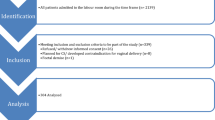Summary
Fifty mothers (study group) who suffered a threatened abortion whose pregnancy continued at least till 28 weeks gestation were compared to the next matched delivered mother (control group). Study mothers were at risk of perinatal death from abruptio placentae, post-partum haemorrhage, retained placentas and a small baby. Those study mothers with severe symptoms delivered earlier.
Abortion is the commonest cause of pregnancy failure. Statistics from our hospital (for the last decade) reveal that 11% of pregnant women seen aborted. The real incidence of abortion we now know is even higher as beta-chorionic gonadotrophin assay reveals that abortion commonly occurs before a missed period1, and also patients with complete abortions may not be referred to hospital.
Threatened abortion occurs in 16% of pregnancies2. Hospital based studies indicate that half these pregnancies will continue though numbers will be influenced by individual admission policy. The earlier the bleeding the greater the risk of loss3, but this is only 9.3% if the fetal heart can be shown on ultrasonography4. Comparative studies show that should pregnancy continue to viability there is a higher incidence of pre-term births, small for gestation age babies, retained placentas5 and perinatal deaths6. Many such studies exclude mothers whose bleeding did not require hospital admission and patients were not always matched with controls. We thought it opportune to compare patients seen in our hospital who had experienced a threatened abortion whose pregnancies continued with matched controls.
Similar content being viewed by others
References
Lenton, E. A., Sulaiman, R. Plasma concentration of human chorionic gonadotrophin from the time of implantation until the second week of pregnancy. Fertil. Stezil. 1982: 37, 773.
South, J., Naldrelt, J. The effect of vaginal bleeding in early pregnancy on the infant born after the 28th week of pregnancy. J. Obstet. Gynaecol. Br. Emp. 1973: 80, 236–41.
Johannsen, A. The pronosis of threatened abortion. Acta Obstet. Gynaec. Scan. 1970: 49, 89–93.
Bennett, M. J., Keil-Wilson, R. M. J. Evaluation of threatened abortion by ultrasound. Int J Gynaecol. Obstet. 1980: 17, 382–384.
Hertz, J. B., Heisterberg, L. The outcome of pregnancy after threatened abortion. Acta Ibstet. Gynaecol. Scand 1985: 64, 151–156.
Funderburk, S. J., Guthrie, D., Meldrum, D. Outcome of pregnancies complicated by early vaginal bleeding Br. S. Ibstet. Gynaecol. 1980: 87, 100–105.
Cassidy, M., Baker, S., Stack, J., Murphy, H. Risk factors and perinatal problems in small for gestational age pregnancies. Irish J. Med. Science. 1985: 154, 237–239.
Beischer, N. A., Abell, D. A., Drew, J. H. Intrauterine growth retardation, in Studd, J. (Ed.). Progress in Obstetrics and Gynaecology. 1984: 4, 82–89.
Author information
Authors and Affiliations
Rights and permissions
About this article
Cite this article
Bowe, P., Murphy, H. Complications of pregnancy following threatened abortion. I.J.M.S. 156, 328–329 (1987). https://doi.org/10.1007/BF02951265
Issue Date:
DOI: https://doi.org/10.1007/BF02951265




